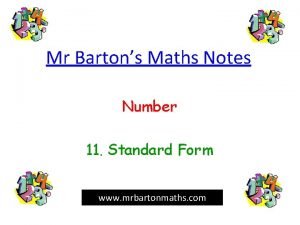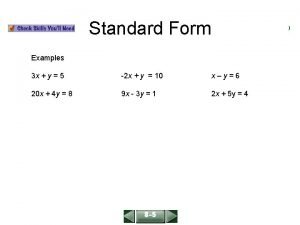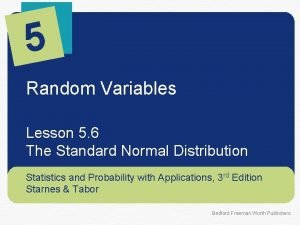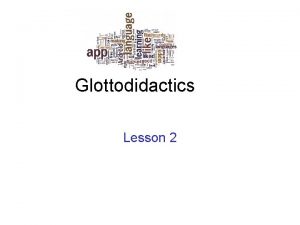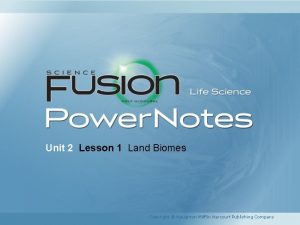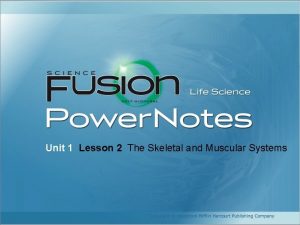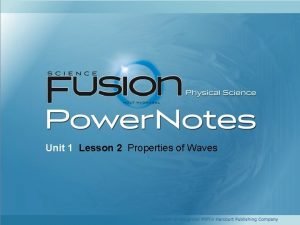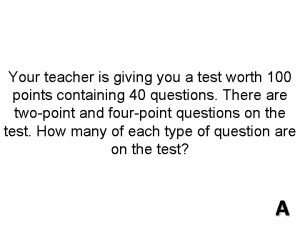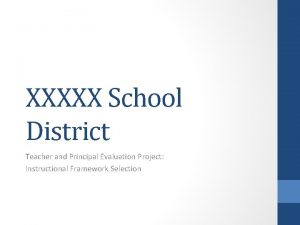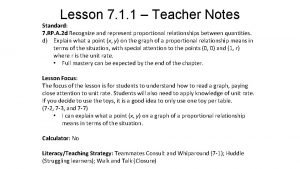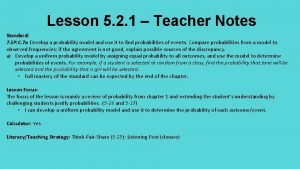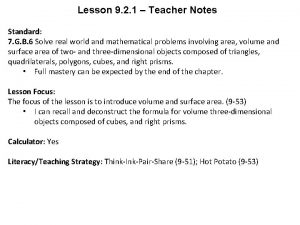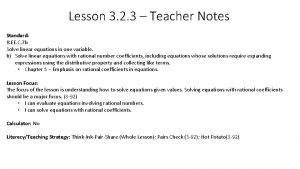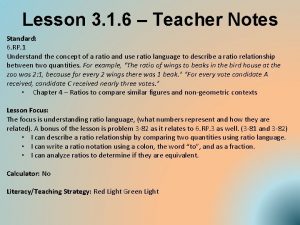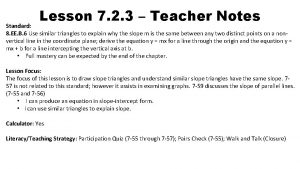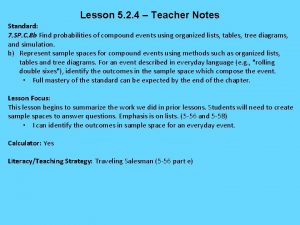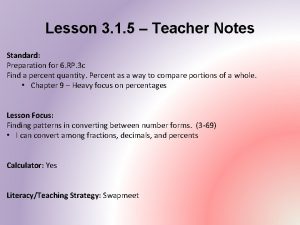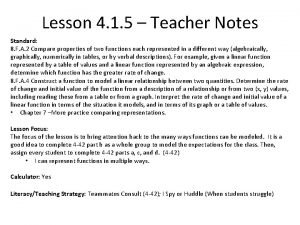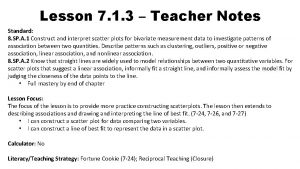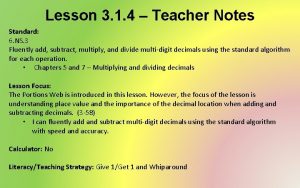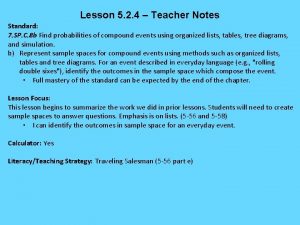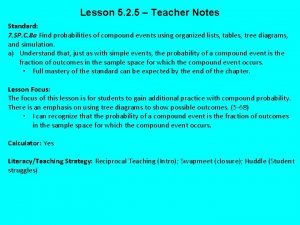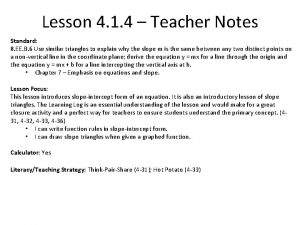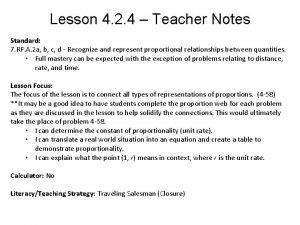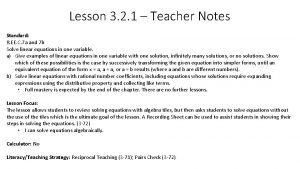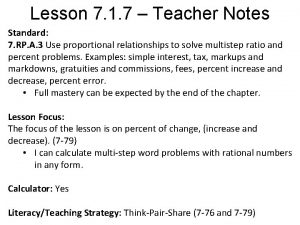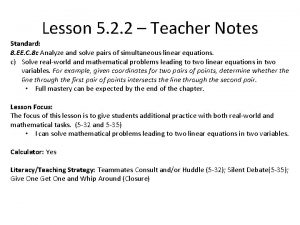Lesson 5 2 3 Teacher Notes Standard 7



































- Slides: 35

Lesson 5. 2. 3 – Teacher Notes Standard: 7. SP. C. 6 Approximate the probability of a chance event by collecting data on the chance process that produces it and observing its long-run relative frequency, and predict the approximate relative frequency given the probability. For example, when rolling a number cube 600 times, predict that a 3 or 6 would be rolled roughly 200 times, but probably not exactly 200 times. • Full mastery of the standard can be expected by the end of the chapter. 7. SP. C. 8 b Represent sample spaces for compound events using methods such as organized lists, tables, tree diagrams, and simulation. • Full mastery of the standard can be expected by the end of the chapter. Lesson Focus: The focus is to introduce the difference between independent and dependent probability. This builds on the work with theoretical and experimental probability. Students should also identify the sample space in an event. (5 -43) • I can determine the relationship between experimental and theoretical probabilities by using the law of large numbers. The lesson also introduces how to represent a sample space for a compound event using an organized list. Literacy/Teaching Strategy: Think-Pair-Share (5 -43); Walk and Talk (Closure)

Probability of Compound Events

Probability of Compound Events Objective: (1) Students will be able to find the probability of a compound event. (2) Students will be able to understand the distinction between simple events and compound events. Essential Question: (1) How do I find the probability of a compound event? (2) How can I distinguish between a simple and compound event?

Vocabulary: Outcome – one possible result of a probability. § Sample Space – the list of possible outcomes for a probability event. § Random – outcomes that occur at random if each outcome is equally likely to occur. § Compound Event – a specific outcome or type of outcome. § Complementary Events – the events of one outcome happening and that outcomes not happening are complimentary; the sum of the probabilities of complementary events is 1.

What is a PROBABILITY? - Previously we looked at probability for simple individual events - If a simple event involves one, independent event, compound events include two or more simple events

What is a PROBABILITY? P(event) = number of favorable outcomes number of possible outcomes Examples that use Probability: (1) Dice, (2) Spinners, (3) Coins, (4) Deck of cards, (5) Evens/Odds, (6) Alphabet, Etc.

What is a PROBABILITY? 0% 25% 50% 75% 100% 0 ¼ or. 25 ½ 0 r. 5 ¾ or. 75 1 Impossible Not Very Likely Equally Likely Somewhat Likely Certain

Probability of Compound Events What are COMPOUND EVENTS? - There are (2) types of compound events: (1) Independent Events – involves two or more events in which the outcome of one event DOES NOT affect the outcome of any other events Examples: roll dice, coin flip, problems with replacement P(A and B) = P(A) x P(B)

Probability of Compound Events What are COMPOUND EVENTS? - The second type of compound events is: (2) Dependent Event - involves two or more events in which the outcome of one event DOES affect the outcome of any other events Examples: deck of cards, selecting item from container, problems without replacement P(A and B) = P(A) x P(B following A)

Probability of Compound Events Example 1: Roll a dice. What is the probability of rolling back to back sixes? P(6, then 6) = What type of probability is this? ? ? Independent

Probability of Compound Events Example 2: Roll a dice. What is the probability of rolling back to back evens? P(even, then even) = What type of probability is this? ? ? Independent

Probability of Compound Events Example 3: Flip a coin. What is the probability of flipping back to back heads? P(head, then head) = What type of probability is this? ? ? Independent

Probability of Compound Events Example 4: Deck of Cards.

Probability of Compound Events Example 4 a: Deck of Cards. What is the probability of drawing 2 hearts (without replacement)? Hint: (1) how many cards are in a deck (2) how many hearts are in a deck (3) if you draw a heart, how many of hearts are left? How many cards are left? What type of probability is this? ? ? P(heart, then heart) Dependent

Probability of Compound Events Example 4 b: Deck of Cards. What is the probability of drawing 2 hearts (with replacement)? Hint: (1) how many cards are in a deck (2) how many hearts are in a deck (3) if you draw a heart and replace it, how many hearts are left? How many of cards are left? What type of probability is this? ? ? Independent P(heart, then heart) =

Probability of Compound Events Example 4: Deck of Cards.

Probability of Compound Events Guided Practice: Questions. (1) Wyatt has four $1 bills in his wallet and three $10 bills in his wallet. What is the probability he will reach into his wallet twice and pull out a $1 bill each time? (Assume he does replace the first bill) P($1, then $1) = What type of probability is this? ? ? Independent

Probability of Compound Events Guided Practice: Questions. (2) A bag contains 3 green and 2 purple marbles. What is the probability of drawing two purple marbles in a row from the bag if the first marble is not replaced? What type of probability is this? ? ? Dependent

Probability of Compound Events Independent Practice: Questions. (1) Wyatt has four $1 bills in his wallet and three $10 bills in his wallet. What is the probability he will reach into his wallet twice and pull out a $10 bill each time? (Assume he does not replace the first bill) P($10, then $10) = What type of probability is this? ? ? Dependent

Probability of Compound Events Independent Practice: Questions. (2) A bag contains 3 green and 2 purple marbles. What is the probability of drawing two purple marbles in a row from the bag if the first marble is replaced? P(purple, then purple) = What type of probability is this? ? ? Independent

Probability of Compound Events Real World Example: Best Buy is having an IPOD giveaway. They put all the IPOD Shuffles in a bag. Customers may choose an IPOD without looking at the color. Inside the bag are 4 orange, 5 blue, 6 green, and 5 pink IPODS. If Maria chooses one IPOD at random and then her sister chooses one IPOD at random, what is the probability they will both choose an orange IPOD? P(orange, orange) · What type of probability is this? ? ? Dependent

Probability of Compound Events Real World Example: Joanna had 3 roses, 4 tulips, and 1 carnation in a vase. She randomly selected one flower, took a photo of it, and put it back. She then repeated the steps. What is the probability that she selected a rose both times? What type of probability is this? ? ? Independent

Probability of Compound Events Summary: The difference between simple and compound events: (1) simple event – a specific outcome or type of outcome. (2) compound event – events which consist of two or more simple events.

Probability of Compound Events Summary: The difference between independent and dependent events: (1) independent event – two or more simple events in which the outcome of one event DOES NOT affect the outcome of other event(s) (2) dependent event – two or more simple events in which the outcome of one event DOES affect the outcome of other event(s)

When you studied probability in earlier lessons, you focused on probabilities of single events (for example, one draw of a card, or picking one cube from a bag). You also examined probabilities of either one or another of two events occurring (for example, winning either a raffle ticket or cash; drawing either a king or queen). In this lesson, you will begin to investigate when one and another event both occur, such as flipping two coins or spinning a spinner multiple times. Throughout this lesson, use these questions to help focus your team’s discussion: • Does the result of one event affect the other? • How many possibilities are there?

5 -43. In Chapter 1, you met Chris and her older sister, Rachel, who made a system for determining which one of them washes the dishes each night. Chris has been washing the dishes much more than she feels is her fair share, so she has come up with a new system. She has proposed to Rachel that they get two coins, and each day she and Rachel will take a coin and flip their coins at the same time. If the coins match, Chris washes the dishes; if they do not match, Rachel washes the dishes. Explore using CPM Probability e. Tool.

5 -43 cont. Rachel thinks that this is a good idea and that her little sister is very silly! She thinks to herself, “Since there are two ways to match the coins, Heads-and-Heads or Tails-and-Tails, and only one non-match, Heads-and-Tails, then Chris will STILL wash the dishes more often. Ha!” a. Do you agree with Rachel? Why or why not? b. Does it matter if they flip the coins at the same time? That is, does the result of one coin flip depend on the other coin flip?

5 -43 cont. c. What are all of the possible outcomes when the girls flip their coins? Organize the possibilities. Use the word “and” when you are talking about both one thing and another occurring. d. Look at your list from part (c). Imagine that the coins are a penny and a nickel instead of two of the same coin. Does your list include both the possibilities of getting a heads on the penny and tails on the nickel and vice versa? If not, be sure to add them to your list. e. Is Rachel right? Does this method give her an advantage, or is this a fair game? What is theoretical probability for each girl’s washing the dishes?

5 -44. ROCK-PAPER-SCISSORS Read the rules for the Rock-Paper-Scissors game. Is this a fair game? Discuss this question with your team. a. In the game Rock-Paper-Scissors how many events are occurring at one time? b. If you and a partner are playing the game and you both “go” at the same time, does your choice affect your partner’s choice? Explain. c. Independent Events - Events where the outcome of one event does not affect the outcome of the other event. Dependent Events- Events where the outcome of one event affects the outcome of the other event. Are the two events in this game independent or dependent?

d. Work with your team to determine all of the possible outcomes of a game of rock-paper-scissors, played by two people (call them Person A and Person B). For each outcome, indicate which player wins or if there is a tie. Be prepared to share your strategies for finding the outcomes with the class. 5 -45. Is Rock-Paper-Scissors a fair game? How can you tell?

5 -46. Imagine that two people, Player A and Player B, were to play rock-paper-scissors 12 times. a. How many times would you expect Player A to win? How about Player B? b. Now play rock-paper-scissors 12 times with a partner. Record how many times each player wins and how many times the game results in a tie. c. How does the experimental probability for the 12 games that you played compare to theoretical probability that each of you will win? Do you expect them to be the same or different? Why?

5 -47. Identify the situations below as either dependent or independent events. Flipping a “heads” on a quarter and then flipping another “heads. ” a. Choosing a jack from a standard deck of cards, not putting it back in the deck, and then choosing a king. b. Picking a blue marble from a bag of marbles, putting it back, and then picking a blue marble again. c. Rolling a 6 on a number cube three times in a row.

Extra Practice #1 Dr Float is rewarding all students that have perfect attendance with an ice cream party. The students will have three flavors to choose from: chocolate, vanilla or strawberry. They have a choice between two toppings: hot fudge or caramel. a. Create an organized list to show all possible choices (sample space). b. How many possible outcomes are there? 6 outcomes Ch / hot fudge Ch / caramel Vanilla / hot fudge Vanilla / caramel Straw/ hot fudge Straw / caramel

Extra Practice #2 Chuck is taking his kids to the store to buy new Converse shoes. He is given a choice of high top or low top. They may also choose from the colors red, gray, black, or pink. a. Make an organized list of all the possible outcomes (sample space). b. How many possible outcomes are there? 8 outcomes High/red High/gray High/black High/pink Low/red Low/gray Low/black Low/pink

Practice Pick up the practice packet and begin working.
 Facteur g
Facteur g Requirements for erf for master teacher
Requirements for erf for master teacher Good afternoon my dear students
Good afternoon my dear students Standard form maths
Standard form maths Standard error in the mean
Standard error in the mean What language you speak at home
What language you speak at home Standard cost is predetermined cost
Standard cost is predetermined cost Kurikulum kssm
Kurikulum kssm Lesson 6-3 standard form answer key
Lesson 6-3 standard form answer key Lesson 5.6 the standard normal distribution
Lesson 5.6 the standard normal distribution Lesson outline lesson 3 describing circuits answers
Lesson outline lesson 3 describing circuits answers Lesson outline lesson 3 mountain building answers
Lesson outline lesson 3 mountain building answers Lesson outline lesson 2 aquatic ecosystems answer key
Lesson outline lesson 2 aquatic ecosystems answer key Define micro lesson
Define micro lesson Post-lesson assessment: l 101 lesson 1
Post-lesson assessment: l 101 lesson 1 Ravi poured the milk for the kitten that he brought from
Ravi poured the milk for the kitten that he brought from Chapter 1 lesson 1 your total health lesson 1 quiz answers
Chapter 1 lesson 1 your total health lesson 1 quiz answers Weather forecasts lesson 3 outline answers
Weather forecasts lesson 3 outline answers Sat vocabulary lesson and practice lesson 4
Sat vocabulary lesson and practice lesson 4 Lesson 2 physical properties answer key
Lesson 2 physical properties answer key The science duo physical and chemical changes
The science duo physical and chemical changes Lesson 1 climates of earth
Lesson 1 climates of earth Lesson outline lesson 1
Lesson outline lesson 1 Lesson outline lesson 1: understanding science answer key
Lesson outline lesson 1: understanding science answer key Galton details
Galton details Biome
Biome Lesson 4 gravity and motion lesson review
Lesson 4 gravity and motion lesson review Lesson outline lesson 2 the muscular system answer key
Lesson outline lesson 2 the muscular system answer key Lesson outline lesson 2 wave properties answer key
Lesson outline lesson 2 wave properties answer key Today's lesson or today lesson
Today's lesson or today lesson 1 important lesson that is worth sharing about this lesson
1 important lesson that is worth sharing about this lesson Today's lesson or today lesson
Today's lesson or today lesson Scrap heap magnet circuit diagram
Scrap heap magnet circuit diagram The sun-earth-moon system worksheet answers lesson 1
The sun-earth-moon system worksheet answers lesson 1 One night a theater sold 548 movie tickets
One night a theater sold 548 movie tickets Xxxx with teacher
Xxxx with teacher



